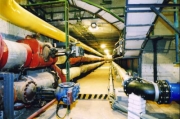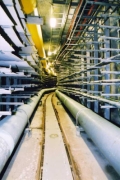If you have any information that explain the approaches of privatization please send it to me.
Saturday, October 10, 2009
Privatization of utility tunnel
If you have any information that explain the approaches of privatization please send it to me.
Sunday, September 20, 2009
Singapore high voltage cable tunnels
Large diameter tunnels for high voltage power circuits


Partition walls being errected in Gambas shaft
The initial scope of the study addressed the feasibility and implications of installing high voltage cables in tunnels, plus the design of two tunnels between Senoko power station and Gambas Avenue in the north of Singapore and between the sub-stations at Ayer Rajah in the west and Paya Lebar in the east. The study also developed route options and planning procedures for constructing an island-wide network of cable tunnels.
The Senoko to Gambas Avenue tunnel comprises 1.7km of twin 3.5m diameter tunnels accommodating ten power circuits. This contract includes the construction of four deep shafts. The Ayer Rajah to Paya Lebar tunnel totals 17km in length and measures 6m in diameter, also housing ten power circuits. The design includes ten shafts, with a maximum depth of 55m for general construction purposes plus cable entry and the permanent ventilation of the tunnels.
The feasibility of a third tunnel between Seraya and Labrador Sub-station, along the west coast of the island was also included in the study. The 8.5km route (4km of undersea tunnel and 4.5km of land tunnel) examined new bored and immersed tunnel solutions and the refurbishment of the existing undersea cable tunnel. Preliminary engineering was undertaken and tender documentation prepared to enable design-and-build contracts to be sought.
Fundamental to the design are the cooling requirements for the power circuits, the overall ventilation of the tunnels and space for installation of the circuits, safe working, maintenance and jointing. The tunnels and control buildings are equipped with fire and life safety facilities designed and specified by Mott MacDonald specialists.
Our commission on the project included the management of the overall tender process and went on to involve construction supervision. Completion of the Gambas Avenue and Labrador tunnels is scheduled for 2005.

TBM assembly in Gambas shaft

Gripper shield front

Errection of cutter head in Gambas shaft

Completed east tunnel of Senako Gambas project
source:
http://www.tunnels.mottmac.com/projects/?mode=type&id=3317
Wednesday, September 9, 2009
New utility tunnel for Africa’s busiest harbour

Northerly view across entrance of the harbour, along the line of existing tunnel
Dredging works for the harbour expansion will cut through the existing tunnel. This means that the new, longer and deeper tunnel needs to be in place and fully fitted-out before the harbour expansion can begin – resulting in a tight design and construction schedule.
Mott MacDonald was part of the team that won the design competition for the type of tunnel that should be constructed, and was awarded the contract to develop the tunnel for Durban’s eThekwini Municipality Water and Sanitation. The competition involved both the new utility tunnel and a 'people mover' tunnel, which would ferry people across the harbour to help in promoting tourism. However, this second tunnel was omitted from the construction contract.
Working with South African engineers, Goba, our design role involved providing technical assistance on the various tunneling options as well as advice on the people mover options and soft ground tunneling. South Africa has strong experience and knowledge in hard ground tunneling, but not as much practice in soft ground tunneling. The ground conditions encountered included river deposits and sandy clay which suited the use of a slurry tunneling machine, which had not previously been used in southern Africa.
Construction work on the tunnel commenced in mid 2005. Of particular note was the steep 20%gradients on each side of the crossing, and the use of a purpose-built vehicle to deliver the tunnel segments. Mott MacDonald had a permanent presence on the site during construction. Although the start-up of the tunneling works proved difficult, the works were completed only slightly behind schedule in August 2006.

Exisiting tunnel landfall structure on the southern side of the harbour entrance

Delivery of the Tunnel Boring Machine

Segments are stored ready for use

TBM being lowered into shaft

The TBM is prepared for launch.

Purpose-built vehicle for segment delivery

Test ring of tunnel segments
source:
http://www.tunnels.mottmac.com/projects/?mode=type&id=9568
Saturday, September 5, 2009
US Perspective: Challenges of Underground Facilities in Urban Areas
A.E. Elioff, Senior Professional Associate Project Management, Tunnel Engineering, PB Americas, Inc. and
C. Laughton, Project Manager for Underground Design and
Construction at Fermi National Accelerator Laboratory


The presentation will illustrate challenges to underground construction (in the USA, urban areas) using illustrations from both successful and unsuccessful underground projects – and the impact of these on current and planned underground construction. Projects are expected to include CSO/Water tunnels, NUMI and DUESL Projects,
WAMATA extension, (Virginia) Alaska Way Viaduct - Seattle, Los Angeles Metro System and Central Artery in Boston.
Paper
US Perspective: Challenges of Underground Facilities in Urban Areas
Presentation
US Perspective: Challenges of Underground Facilities in Urban Areas
Tuesday, August 25, 2009
Trenchless technology

Trenchless technology, often referred to as "no dig", is a rapidly growing engineering industry that eliminates the need for surface excavation. Trenchless technology is also used to minimize environmental damage and to reduce the costs associated with underground work. In other words, trenchless technology provides cost-effective sewer asset management. It involves pipe and sewer inspection, rehabilitation, and cleaning services.
"No dig" is exactly what it sounds like. There is no digging up of roads to replace gas and water pipes. When there is a need for pipe rehabilitation in the middle of a busy intersection, trenchless technology allows you to repair the pipe without having to dig up the entire road. Not only does this eliminate traffic problems, but it saves money because you do not need to repair the road that you would normally have dug up.
One of the most recent developments in trenchless technology is the use of robotics. One of the core benefits of using robotics is the measurable data it provides that allows agencies to better understand the state of their current systems. Robots are also able to enter hazardous environments that are too dangerous for people to access.
Wednesday, August 19, 2009
Prague's utility tunnels
"Prague is the only capital city that has nearly completed a comprehensive network of tunnels which serve the most important parts of the city. The overall length is 90 kilometers. Compare it to Berlin - it has 25 kilometers, Paris has around 20 kilometers. It is not a problem to add any new wires or pipes - the system has been built to last for 200 years and to contain networks which don't yet exist today. Also, even before 2001 we implemented excellent security systems - of course, I'm not going to disclose any details. We have practically excluded the possibility of anyone getting into these systems. With gas pipes and so on, they could be potentially very vulnerable. It was an idea that no one else had had."
Visitors to the underground tunnels are equipped with overcoats and hard hats and a tour guide shows them round some of the most interesting parts. I asked Otakar Capek which utilities can be found there.
 "Everything from gas pipes, steam pipes, water mains, to pneumatic postal service, high and low voltage cables, data cables, telecommunications cables and also special networks connecting individual companies. We have even been asked to install pipes to draw beer from restaurants."
"Everything from gas pipes, steam pipes, water mains, to pneumatic postal service, high and low voltage cables, data cables, telecommunications cables and also special networks connecting individual companies. We have even been asked to install pipes to draw beer from restaurants."
Otakar Capek says the utility tunnels or "kolektory" as they are called in Czech are a living organism which evolves constantly. In the deepest corridors, some 30-40 meters underground, a special train runs on five-kilometer routes transporting pipes, metal parts and other components. The tunnel is never complete; it is a never-ending process, says Otakar Capek and adds that this system, which he is so proud of, was mostly built during a historical period that tends to be looked down upon - the socialist era.
"Even in those days when there was a group of people who believed in something, who thought they were working on something meaningful, they could make it happen. The construction indeed had flaws of the socialist era. For example, after 1989 we had to renovate everything that did not meet safety standards. Such as fire doors made of cardboard, weak ventilators and so on."
 The Prague utility tunnels are looking forward to welcoming more tourists thanks to this new coordinated project, which is opening Prague's technological heritage to the public. And director Otakar Capek says there is more to see than wires and vaults.
The Prague utility tunnels are looking forward to welcoming more tourists thanks to this new coordinated project, which is opening Prague's technological heritage to the public. And director Otakar Capek says there is more to see than wires and vaults.
"Prague is a tectonically stable area but the geology is very complex. You can find gravel sands here, clay, slate, etc., and all that poses many problems. When we were digging the big tunnel between the Municipal House and the bottom of Wenceslas Square, we basically followed the route of a 13th century ditch. It was full of objects discarded there and remnants of the old city walls which were later demolished. We worked with archaeologists and many of the objects that we found are on display right there in the tunnel."
Individual companies in Prague are now joining the venture which hopes to boost incoming tourism in the capital. When can visitors see the newly opened technological monuments? Jan Hauser of the Prague Chamber of Commerce.
"This would obviously be a question for the owners and the people who are running these sites but we hope that this summer, meaning the summer of 2007, should be the time when the first doors are opened."
Tuesday, August 18, 2009
Utility Tunnel Alternatives
• Reduced road digging costs that involve traffic, road restoration difficulties and safety hazards.
• Reduced maintenance costs
• Reduced energy losses
• Utilization of public ground
• Better use of resources
• Knowledge about the utilities
• Monitoring and control
• Lower material and pipeline costs
• Encourage mid and long-range thinking
• Improved public safety
• Initial costs
• Coordination of authorities
• Complex design
• Tunnel management
• Security



